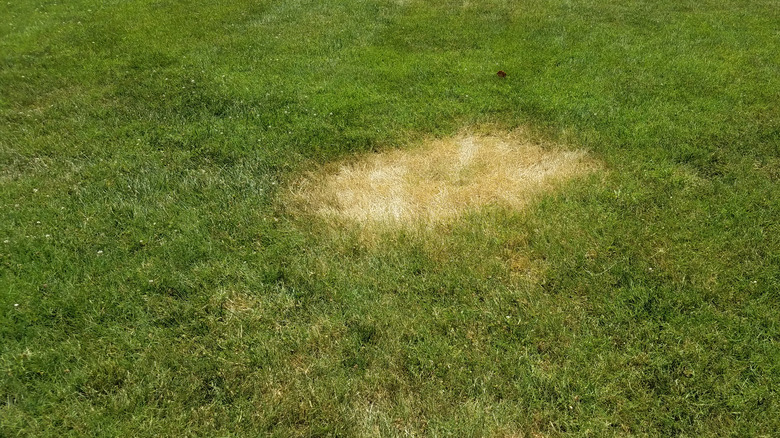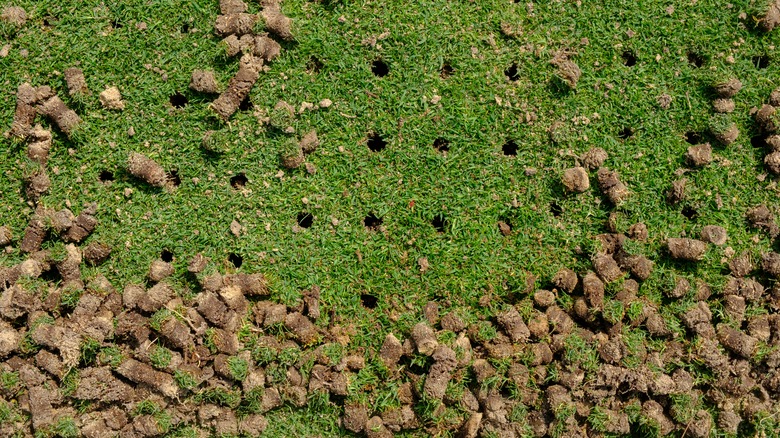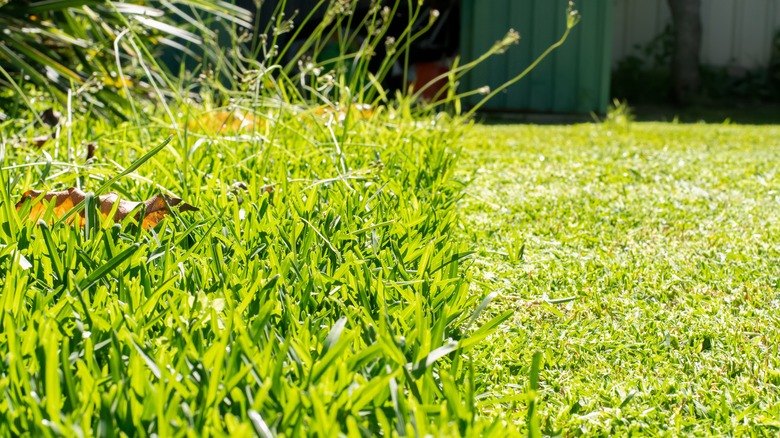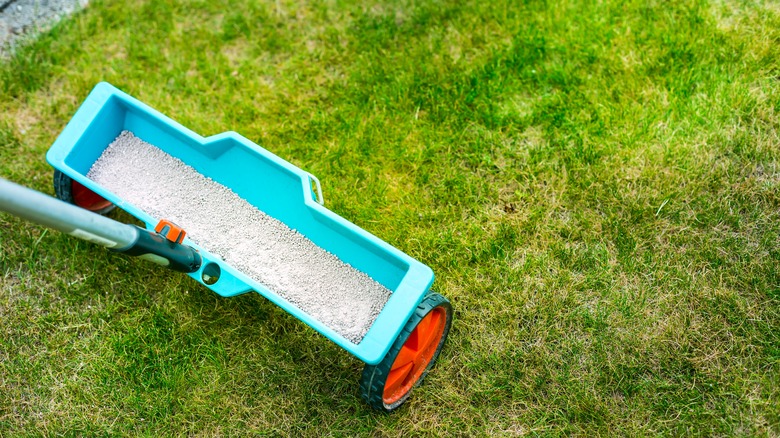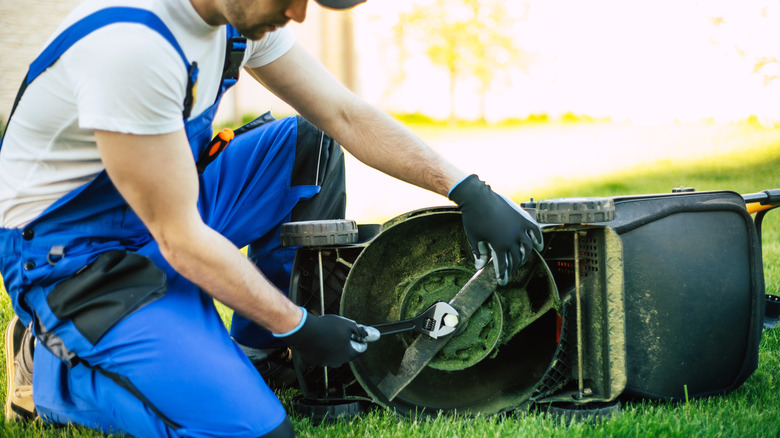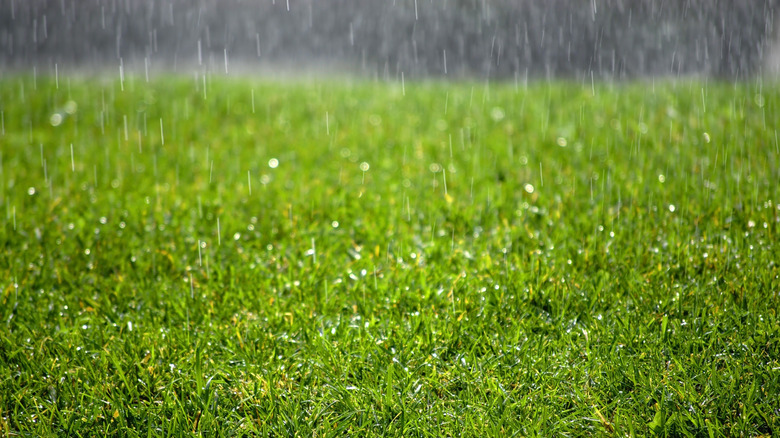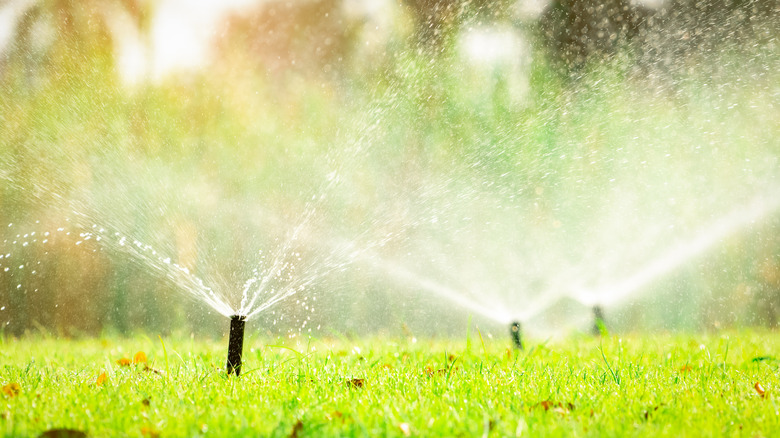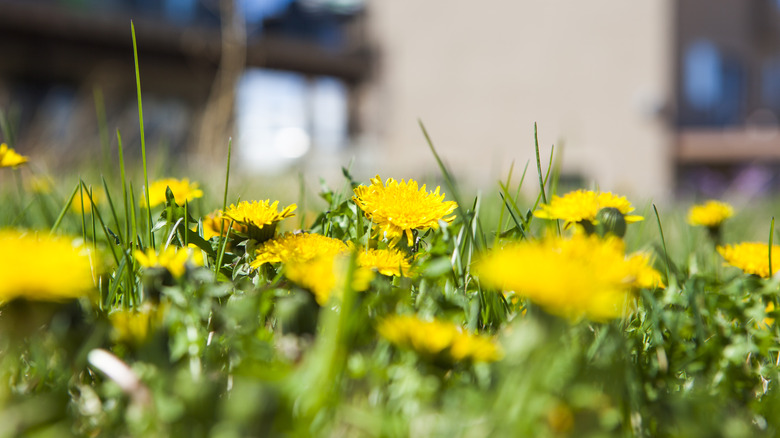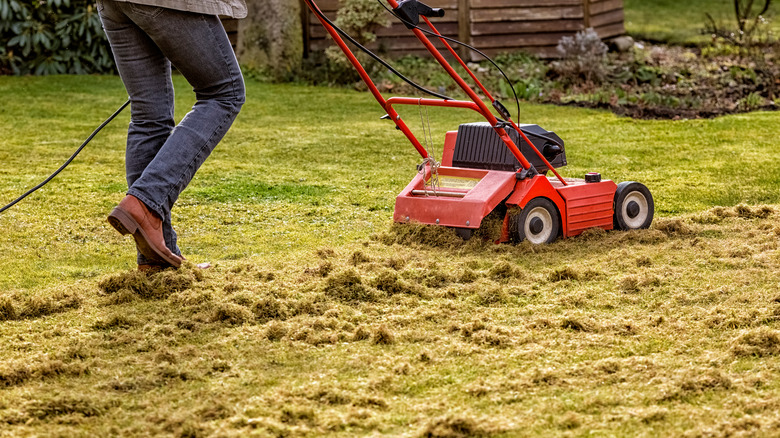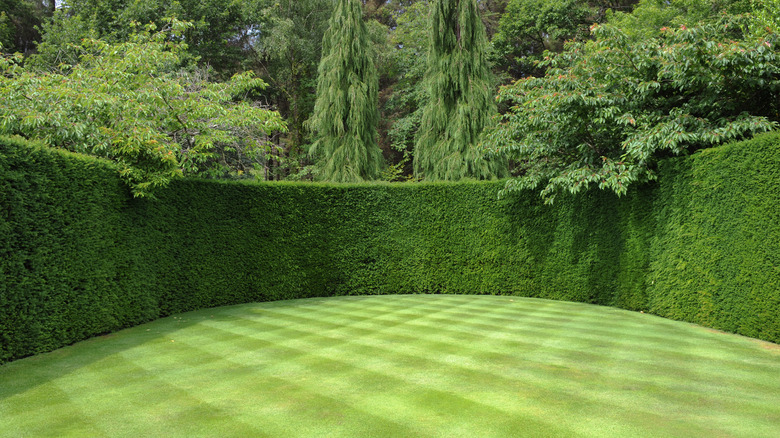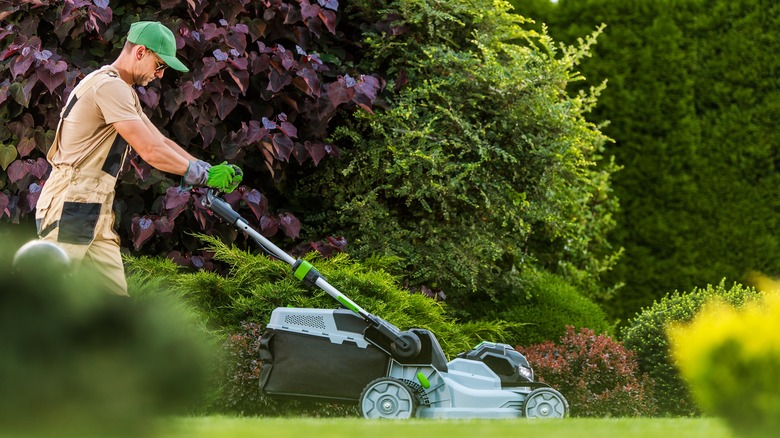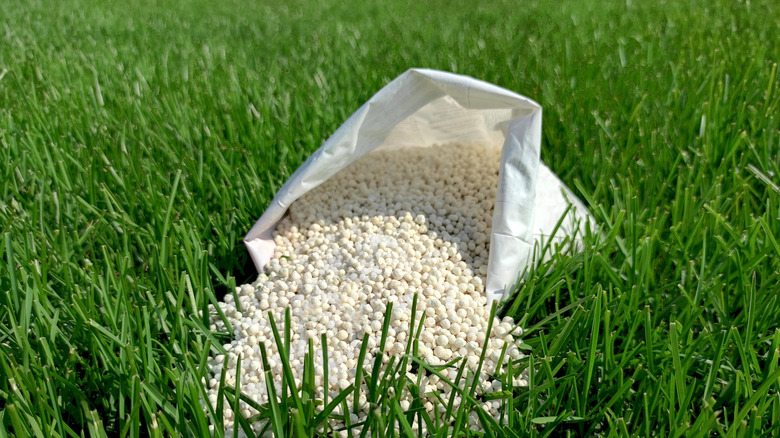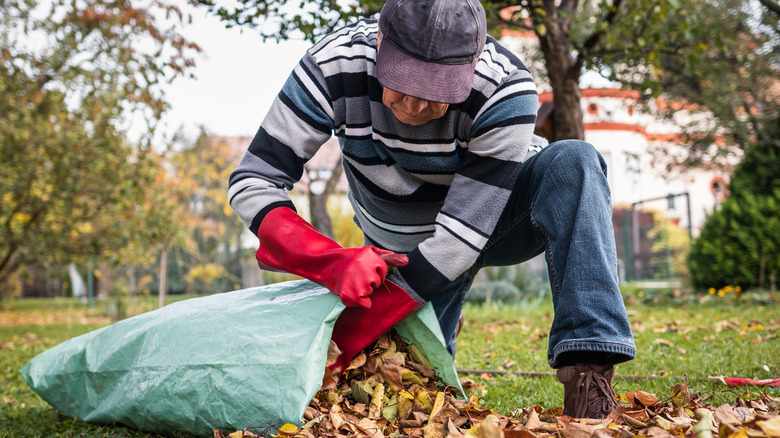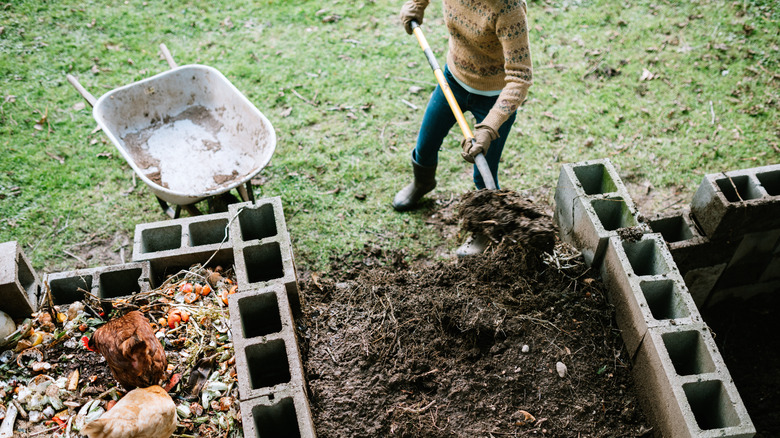14 Surprising Ways You've Been Killing Your Grass Without Knowing It
It's no secret that maintaining a healthy lawn — lush enough to make the neighbors gush — is a big undertaking. New homeowners learn quickly that there's an inordinate amount of information they don't yet know. Meanwhile, across the street, a seasoned homeowner is still trying to figure it all out after decades of practice with the mower and the fertilizer and the rake and the compost. More often than not, what you don't know can trip you up the most. Regardless of how much time and effort you've been putting into your lawn, there are a lot of surprising ways that you may be killing your grass.
It could be that the problem lies under heavily compacted soil, just as it could be that it exists right in front of your face at surface level. Learning to avoid these all-too-common mistakes will give you the confidence you need to take on the largest of lawns, and the results will yield a gorgeous yard that you can enjoy for many years to come.
Compacting the soil without aerating
Every time you walk across your lawn, run the lawn mower, or roll something like a wheelbarrow around, you compact your soil. Simply put, the air is being squeezed out and particles are getting pressed together. As the soil becomes extremely dense, it gets harder and harder for oxygen and water to make their way down to the roots of the grass, and it can cause water to eventually pool on the surface. This problem worsens when you experience long periods of rain and can lead to root rot.
Aerating is the process of either digging spikes into the lawn to create holes or pulling up plugs of compacted dirt to loosen the soil and let oxygen and water rush in. Lawn care professionals can certainly do this, but aerating your lawn is also a manageable DIY project you can complete on a weekend so long as you have the correct tools. Don't worry about having to invest in pricey machines; your local hardware store should have something appropriate to rent, and the staff will be able to help you figure out which type (spike or plug) is best for your yard.
Cutting grass too short
Cutting the grass super short is known in the industry as scalping, and it's very bad for your lawn. In fact, some would say it's one of the biggest mistakes you can make. It helps to think of each blade of grass as a leaf on a larger plant. Leaves drive photosynthesis and keep the overall plant healthy. If you cut them all too short, they must work much harder to stay alive. Cutting low to the ground also puts the crowns of the plants in danger. Just as our own bodies would do anything it takes to save our organs in a dire situation, grass plants are going to focus all of their resources on recovering a damaged crown. Before you know it, the blades will weaken and become susceptible to weeds, grubs, and all sorts of other health-related issues and diseases.
Mow warm season turf to a length that falls between 1 to 3 inches, and mow cool season turf closer to 4 inches high. For a lush and healthy lawn, the general rule is to never remove more than ⅓ of the length of the blades each time you cut the grass.
Fertilizing at the wrong time or with the wrong product
Unfortunately, there are a lot of mistakes that can be made when fertilizing your lawn. Applying the wrong kind of fertilizer or fertilizing too often can cause your grass to dry out and burn. Part of the confusion comes from there being so many different types of grass, and then there's the fact that the soil underneath your grass has a life of its own with varying pH levels and nutrient content. If you can invest some time (and a little extra money), performing a soil test and reviewing your options with a professional might be worth your while. This is when the extension service at your local university really comes in handy.
Knowing when to fertilize is important. This is a chore best checked off the to-do list in the fall so that the fertilizer can get to work repairing damage from the long, hot, foot-traffic-heavy summer months and prepare the root system to make it through an equally long and treacherous winter. Some lawns will benefit from a spring application the following season as well.
Forgetting to sharpen your mower blade
As if we needed one more thing to remember to take care of — yes, lawn mower blades require a little attention too. Dull blades cannot make clean cuts, so they ruin a lawn by leaving the blades of grass ragged and frayed, as if they've been ripped out instead of sliced through. This is an excellent way to set up your yard for an influx of disease. Best case scenario, you end up with a lawn that looks messy and has an unappealing brown tint to it. Worst case scenario, your grass starts to die.
If you opt to sharpen the blade yourself, be sure to take out the lawn mower battery or disconnect the spark plugs first for your safety. Once you've removed the blade, use a flat file, a bench grinder, or a blade sharpening drill bit to get it to the point where it is as sharp as a butter knife. A lawn mower blade rotates at such high speeds that it doesn't need to be extremely sharp; you just want to make sure it's not dull. While you're at it, you can give the whole machine a good rinse to clear away grass clippings. Clean and sharpen a lawn mower blade once per season. If you're not down for the sharpening bit, just have it replaced.
Heading out to mow after a rainstorm
A good spell of rain is sure to make your grass bounce back to life, which might feel like reason enough to get a jump on your next mowing. But for the sake of your lawn, it's best to hold tight. Not only will wet grass clump together and create a mess by getting stuck in your freshly sharpened mower blades, but you'll also inadvertently damage the lawn. Diseases naturally occur more frequently in excessively moist conditions. One major problem that can happen if there's already a disease present in the lawn, is that the mower will act as a carrier that spreads it throughout the yard.
Think of it this way: Even if the sun has come back out, if your first instinct is to grab your galoshes before stepping foot in the yard, it's too soon. Let the grass dry to avoid re-compacting the soil, and also to keep yourself safe from potential slip hazards.
Irrigating too much or too little
Grass can be both under-watered and overwatered, both of which can cause your grass to die. So how do we achieve the right amount? It tends to be easier to know if your lawn is under-watered. It can be if you live in an arid climate, the soil is dry and caky, or (let's be honest) you just forgot or completely neglected the watering schedule. An overwatered lawn is a little harder to pinpoint, but there are some telltale signs, like seeing mushrooms pop up and feeling like you're walking on a sponge.
A 30-minute session three times per week is a good starting point; just remember to cut back on that timing if you experience rainfall. In terms of the best time of day to water your lawn, shoot for early morning so the grass has time to dry out before nightfall, when it could otherwise become a breeding ground for fungi and bacteria. If that's not possible, the next best time is early evening. Both of these timeframes allow for the least amount of water loss from evaporation caused by the hot mid-day sun.
Killing weeds with harsh herbicides
If you're putting a lot of time into your lawn, it's likely not only because you want it to be healthy; you want it to look nice too. Presentation matters, so it makes sense that you would get frustrated by bright yellow dandelions and other weeds cropping up and threatening to take over your lovely green grass. But forums across the internet are chock full of stories from well-meaning homeowners who accidentally killed their grass along with the weeds. Just as with fertilizer, it's important to be specific and careful when looking for an appropriate herbicide to kill weeds so you don't end up doing the same.
Misuse of weed killers is a common problem. It could be that the type of grass you have is incompatible with the chosen brand of herbicide, or perhaps the composition was too strong. Maybe you thought you were spot-treating, but the wind carried the spray to another part of the lawn. In particular, be weary of "non-selective herbicides" like glyphosate found in Roundup. These chemicals are formulated to kill every plant they touch, which could mean a sad end to otherwise healthy grass.
Leaving thatch in place
Thatch builds up below the surface of the grass, yet above the roots and soil. It's basically made up of decaying debris that gathers in the yard and has no place to go. A good chunk of thatch usually comes from lignin, which is a compound that makes up wood and takes a long time to break down. The problem with an overabundance of thatch is that it can suffocate your grass, so it's definitely something you want to monitor.
There are some grass species, like Kentucky bluegrass, that are known to produce a lot of thatch. A yard with a pH below 5.5 is also prone to thatch buildup. As with lawn aerators, thatch removal equipment can be rented from garden centers and hardware stores where you might see them listed as dethatchers, vertical lawn mowers, or power rakes. The job can also be done with a standard rake, provided you're thorough and push the rake deep into the grass. Rake the entire lawn in parallel rows, and then immediately go back and do the same with crisscrossing rows. Use the collected thatch as mulch in other areas.
Letting the dogs roam free
It can be hard to keep a good lawn green when you have dogs, but we strongly advocate giving it your best effort. After all, half the fun of having a frisky pet is getting to wrestle and frolic with them outdoors. That said, allowing dogs unrestricted free rein could quickly result in dead grass from digging, rough play, or chemical reactions from urine and feces like nitrogen burn.
You've got a slew of options for comfortably sharing the yard with your furred family members. For starters, you could enclose a play area just for them with a simple fence, or train them to relieve themselves in one specific spot. Other useful tips include keeping the grass and your dogs well hydrated, cleaning up messes as soon as they're made, planting durable grass seeds that can handle heavy foot traffic, and sticking to all-natural formulations for fertilizing and flea prevention.
Mowing in the same direction every time
Detailed, clean lines are one of the hallmarks of a pristine, golf course-worthy lawn, but too much of a good thing can lead to damaged grass. One of the detrimental issues of always mowing a yard in the same direction is that the leaf blades will fail to stand upright. Constantly pressing them in one direction trains them to start growing that way, and the repetitive stress of the lawn mower wheels will compact your soil.
Fixing this problem is as simple as changing directions and mowing in different patterns. Have fun with it while impressing the guests at your next backyard barbecue. Lawns can be cut in checkerboard patterns, stripes, or diamonds. The more creative among us might try circles and waves. If you have persistently leaning grass, add a roller to your arsenal of tools and use it to push the blades to the other side.
Mowing too often or not enough
You can irrigate too little or too much. You can fertilize too little or too much. And, yes, you can also mow too little or too much. Aside from hitting the ideal height of the grass blades with each pass, you also need to be aware of your overall mowing schedule and its impact on your grass. The only way to know how often your lawn needs mowing is to watch it grow. If it's not ready, then mowing too soon could result in bald patches and scalping. This is the same problem you'll have if you cut the blades too short. On the flip side, grass that has been left to grow too long causes issues when it droops and cuts off the supply of oxygen and sunlight to the roots. The result there could be fungal diseases and a thinned-out lawn.
If your grass is actively growing, aim to mow once per week. With a warm season turf, this period of time will occur in the summer. With a cool season turf, it will be spring and fall. Otherwise, twice a month should suffice.
Overfeeding the grass
We've established that it's important to understand what type of fertilizer to use on your lawn and when is the best time to apply it. Another thing to consider is how much to use with each application, because using too much can lead to chemical burns and dead grass. It's possible that nitrogen will be the culprit, but it's more likely to be residual salts. Not only does the sodium damage the grass, but it also leaches into the soil, where it kills beneficial microorganisms.
In addition to chemical burns, overfeeding a lawn can force it to grow faster than its root system can sustain. This means the roots won't have the capacity to take up as much water and nutrition as the plant needs to survive. Too much fertilizer can also throw off the delicate pH balance of the soil, especially if you're not clear on which nutrients are abundant or deficient. Depending on the pH level, some micronutrients will improve conditions, and others will be detrimental.
Raking and bagging up leaves and grass clippings
When homeowners complain about the time-consuming chore of raking and bagging leaves, many a lawn care professional is left scratching their head, wondering why anyone would bother. The task may be built into your routine as an annual necessity, but it usually doesn't need to be. In fact, some experts say it's detrimental to your grass and the overall environment of your yard. A better option is to leave foliage where it lies and run your lawn mower over it. Cutting up the decaying leaves creates a mulch-like consistency that can easily break down and send nutrients back into the soil. If you still feel compelled to make use of the rake, do it with the intention of spreading the leaves to bare spots in the grass where they can do the most good.
Any standard lawn mower should do a decent job of breaking up leaves, but there are mulching mowers on the market that will cut everything up into very fine pieces that will decay faster than large chunks.
Skimping on compost
Compost can be an off-putting subject since its contents are, admittedly, a little gross. Even though dealing with a pile of rotting food waste sounds less than pleasant, it's worth getting into the compost game for the health of your lawn. Without it, the entire ecosystem of your yard may end up lacking the vital nutrients and beneficial organisms necessary for sustained health and vigorous growth.
The application of compost is a process called top dressing, and it's one you want to tackle in the fall or spring. Use a shovel to spread a ¼-inch-thick layer, then gently rake it into the ground so it starts to mix into the soil. Staying in the habit of top dressing will improve the quality of your grass year in and year out. If you're not sold on creating a compost bin to make your own, purchase a bag from a reputable source instead. No excuses; this is the season you start top dressing with compost!
